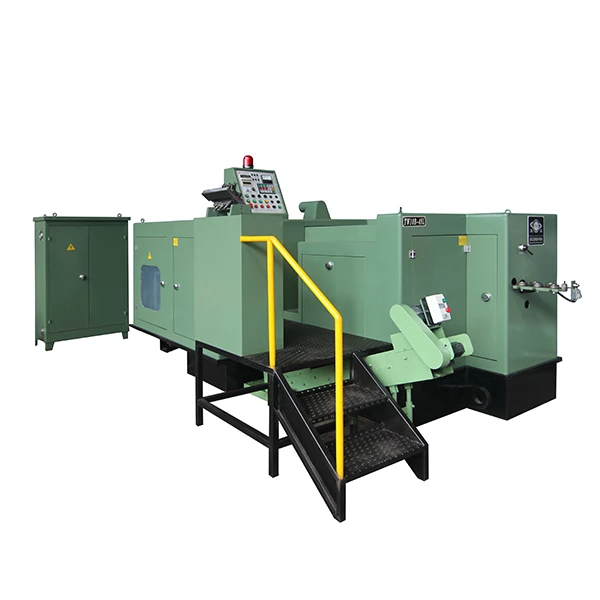The Actual Working Principle And Application Analysis Of Cold Heading Machine
Bolt forging machine play a vital role in modern manufacturing, particularly in metal forming and parts manufacturing, where they have become indispensable equipment. They primarily shape metal materials at room temperature, achieving precise and efficient production goals. They are widely used in various industries, including automotive, electronics, and aviation. To help readers better understand the actual working principles and applications of cold heading machines, this article will detail their operating mechanisms, common applications, equipment selection, and maintenance tips.
How Cold Heading Machines Work
The basic operating principle of a bolt former is to press metal materials into the desired shape using high pressure. This process occurs at room temperature, effectively preserving the metal's strength and hardness and avoiding the potential performance loss associated with heat treatment. The entire process is accomplished through high-precision die design and powerful pressing equipment. During the cold heading process, metal blanks enter the machine and are formed into complex geometric shapes through powerful pressing, preserving the material's original properties while maintaining high production speed and precision.
Main Components
The main components of a bolt former machine include the feed system, forming die, pressing mechanism, and drive system. The feeding system is responsible for accurately feeding the metal blank into the die, ensuring forming accuracy. The forming die is the core component of the entire cold heading machine, and its design precision directly affects the quality of the finished product. The pressing mechanism is typically powered by a powerful hydraulic or mechanical system, ensuring efficient and precise metal forming. The drive system is responsible for transmitting power and ensuring stable operation.
Common Applications of Cold Heading Machines
Cold heading machines are widely used in various industries due to their efficient and precise forming capabilities. The following are several typical applications.
Automotive Industry: In the automotive manufacturing process, cold heading machines are often used to produce parts such as bolts and nuts. These parts require high precision and durability, and cold heading machines effectively ensure that these products do not break or loosen during use due to insufficient strength.
Electronics Industry: Cold heading machines are also widely used in the production of electronic products, such as metal casings and connectors. Due to the high precision requirements of electronic parts, the precision processing characteristics of bolt maker machine ensure stability and reliability.
Aerospace: The aerospace industry places extremely stringent demands on metal parts. Cold heading technology, with its high-precision processing capabilities, enables the production of high-strength fasteners and structural components for aircraft, ensuring their safety and reliability.
Cold Header Types You Can Choose
There are various types of bolt making machine on the market, suited to different production needs, including:
> Hydraulic Cold Headers: Hydraulic cold heading machines are suitable for large-scale production, providing strong pressing force and are ideal for metal forming work involving larger sizes or requiring higher pressure.
> Mechanical Cold Headers: Mechanical cold heading machines utilize a mechanical drive to apply pressure and are suitable for the production of small parts requiring high precision. Their simple structure makes them easy to use and maintain.
> High-Speed Cold Headers: High-speed cold heading machines, with their rapid production capabilities, are particularly popular in industrial applications with short production cycles and high demand. They efficiently complete the continuous forming of metal parts.
> Multifunctional Cold Heading Machine: This type of bolt manufacturing machine offers multiple functions and can perform multiple operations simultaneously, such as punching, coining, and bending. It is suitable for complex production scenarios.
What to Consider When Purchasing
When purchasing a bolt manufacturing machine price, first ensure that the selected equipment meets your production requirements, particularly in terms of part size, production speed, and operating environment. Secondly, the stability and precision of the equipment are crucial, especially the quality of the mold and pressing system, which directly determines the quality of the finished product. The energy efficiency of the cold heading machine should also be considered. Choosing equipment with low energy consumption can help reduce long-term production costs. Furthermore, after-sales service and maintenance support are essential factors when purchasing. Ensure that the equipment receives timely repairs and technical support to avoid long-term downtime during production. Finally, the manufacturer's reputation and the market reputation of the equipment are also important factors in determining the purchase decision.
Money-Saving Maintenance Tips
To extend the life of the cold forge header machine and reduce maintenance costs, regular inspection and maintenance are essential. First, keep the cold heading machine clean and regularly remove oil and metal debris to avoid affecting its operation. Secondly, check the lubrication system to ensure adequate lubrication of the equipment's moving parts to minimize wear. Regularly inspect molds for wear and replace damaged molds promptly to avoid compromising product quality. You can also optimize production processes to reduce equipment overuse and extend its operating life. Furthermore, select appropriate operators and provide them with technical training to avoid unnecessary damage caused by improper operation.
How to Choose the Right Cold Heading Machine
When selecting the right cold header, consider factors such as production needs, equipment specifications, and budget. Understand the advantages and disadvantages of different cold heading machine types and choose the model that best suits your production line, ensuring it meets your requirements for efficiency, precision, and stability. Additionally, choose a brand with excellent after-sales service to ensure long-term stable operation and minimize the impact of unexpected failures.

 English
English اللغة العربية
اللغة العربية Español
Español Português
Português Русский
Русский  Türkçe
Türkçe